The Yellowstone Angler is situated close to the Yellowstone River just south of Livingston, Montana. Within just an hour’s drive, you’ll find a multitude of large western rivers, spring creeks, high mountain streams, local and private lakes, as well as Yellowstone National Park all at our fingertips.
Sound like Fly Fishing Central? It is — and that’s why we live here.
The Yellowstone River is our home river but we also book guide day-trips to most of the famous rivers in Southwest Montana, including the:
And, there are several other waters we’d rather not mention because we keep some of the best-kept secrets close to the chest. For a well rounded trip, we recommend trying a couple of different locations. Give us a call to find out which rivers would suit your style of fishing and we’d be happy to set you up with the best guides for that particular stretch of water. 406-222-7130.
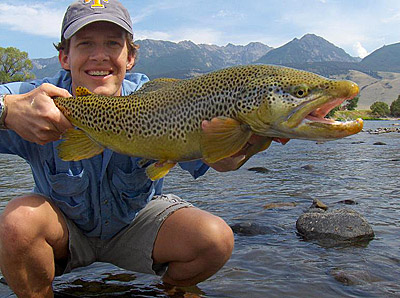
The Yellowstone River is our “home water” and one of the world’s truly great trout streams. The Yellowstone is the longest undammed river in the lower 48 states, and there is excellent trout water from its tributaries high inside Yellowstone Park, downstream through Gardiner, the Paradise Valley, Livingston, and well below Big Timber, a stretch of nearly two hundred river miles. Guides float many different stretches of the prime water between Gardiner and Big Timber, depending on fishing conditions, water levels, and the goals of their clients.
In general, you will catch more fish up high, with a good number of trout being native Yellowstone Cutthroat. Big browns (like the one shown left) can be caught on just about any section of the river. However, you typically need to change your tactics and target these fish specifically. Doing this often means catching less trout, however the ones you do catch will certainly be photo-worthy! Many clients choose to float through Paradise Valley, which is famous for scenic views as well as higher fish counts per mile than other sections. Aside from pre-run off (March – April) the best time to fish the Yellowstone River is a week or two after it clears. Depending on snowpack levels and how fast the snow melts, this typically occurs during mid July. August is the best time to fish hoppers, but the fish have also seen a few more flies by then. October, with less fishing pressure and aggressive pre-spawn browns, is also a good time to fish.
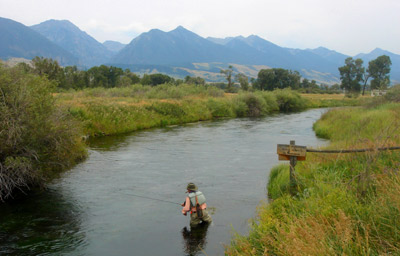
The Paradise Valley spring creeks — Armstrong’s, DePuy’s, and Nelson’s — are located six to eight miles south of Livingston and are easily accessible by car. The spring creeks are small, crystal-clear meadow streams loaded with beautiful, wild fish. These streams bubble up from underground aquifers, and are unaffected by runoff like our other freestone rivers and streams. Their rich waters, flowing at a constant 52-60 degrees, produce dependable and often heavy hatches all season long.
The clear water and slow moving currents demand a careful approach and good presentation of the fly to be successful, but this “technical” fishing offers a nice contrast to the float fishing on a big freestone river like the Yellowstone. Because so much of the fishing is visual, the spring creeks are also an ideal classroom for beginners and experts alike. This is challenging fishing, but the experienced guides on our team can take complete beginners out on the spring creeks and have them catching some very nice fish in short order. Next time you come out, you can fish with your guide again, or try the creeks on your own with the new tricks you’ve learned. Click on the links above or the photos below to read more about each of the Paradise Valley Spring Creeks.
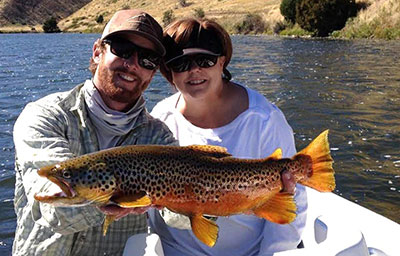
The Lower Madison river has always been one of our favorites, and if we can’t fish the Yellowstone (because it’s blown out with mud or too windy) then you’ll see us over here or on the Upper Madison. On the Lower, we’ll float anywhere between Warm Springs access, (just below the Bear Trap canyon) to the Missouri Headwaters State Park (The confluence where the Jefferson, Madison, and Gallatin come together to form the Mighty MO). There are some huge browns in the Lower Madison, both resident fish and migratory. There are also a ton of crayfish in this section of the river which cause the browns to grow quickly. Although this section is often overlooked by many outfitters and guides, those who know will catch big fish in the Lower Madison every year.
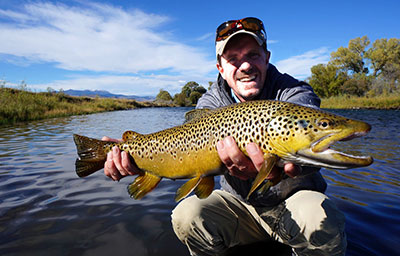
The Upper Madison, although a little further by car than the Lower Madison, is home to some amazingly healthy brown trout. During the epic Salmonfly hatch, big, fat browns will come up out of the lake into the river and chase these big bugs all the way up to Quake Lake. The Upper Madison is very picturesque and, although it does see a lot of boat traffic, the fish (on average) are a little thicker than those on the Yellowstone. During the fall, the same lake-run browns will come up to spawn and there can be some serious hogs caught on streamers. Through the summer we are typically fishing stoneflies, caddis, and attractor nymphs.
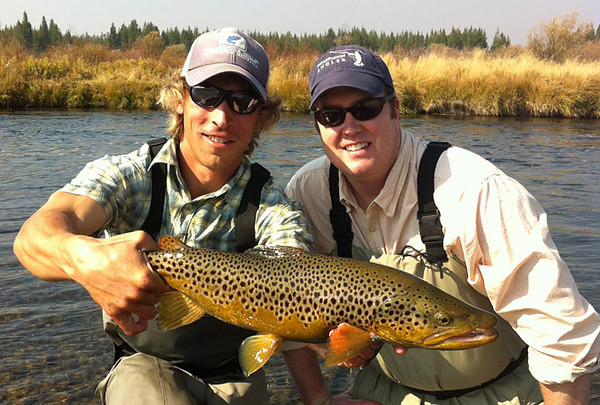
With famous rivers like the:
This world-famous national park offers anglers endless angling opportunities throughout the summer and fall. Whether you are looking to fish close to the road or prefer to hike into Yellowstone’s pristine backcountry, our guides are prepared to show you the trip of a lifetime.
In general, the most epic fishing takes place in hard to find, “off the beaten path” areas. You might get lucky and find one of these spots on your own through exploring, but by booking a guide you are guaranteed to find these “stash waters.” Many of our favorite spots require a 2-6 mile round-trip hike. Die-hard anglers who are in excellent shape can take 10 mile round-trip “hike and strike” trips. During the summer we like to focus on the northeastern section of the park, primarily fishing for native cutthroat trout and brook trout. Come October, our guides like to fish for big lake browns that are in the process of “running up” to spawn later in November.
In general, the most epic fishing takes place in hard to find, “off the beaten path” areas. You might get lucky and find one of these spots on your own through exploring, but by booking a guide you are guaranteed to find these “stash waters.” Many of the our favorite spots require a 2-6 mile round trip hike. Die hard anglers who are in excellent shape can take 10 mile round trip “hike and strike” trips. During the summer we like to focus in the North Eastern section of the park, primarily fishing for native cutthroat trout and brook trout. During October our guides like to fish for big lake browns that are in the process of “running up” to spawn later in November…

Unknown to most, Livingston is surrounded by some of the best stillwater fishing you’ll find anywhere in the world. Large browns, brookies, and rainbows await anglers who are lucky enough to fish these incredible bodies of water. We have some incredible sight fishing to big risers eating callibaetis in May, June, and July. Seeing a 4-7 pound fish move ten feet underwater to eat your dry fly is a feeling few river anglers get to experience. While most of our clients prefer to fish running water, we have a few clients who only fish lakes with us.
Not only are lakes a great option for kids (as they have more opportunities to practice setting the hook, stripping or reeling in fish to stay tight, or letting them run), there is a good chance your biggest fish of the trip will be caught on one of these lakes. We fish these lakes from the comfort of a drift boat.
We recommend booking a guide for these lakes in order to learn new techniques. However, if you are already an advanced stillwater angler with your own watercraft, we can also book your rods. Rod fees range from $60 – $125 per angler per day and the lakes are located anywhere from 20 – 80 miles from the shop. Try mixing one day of lake fishing into your vacation, you’ll be glad you did!
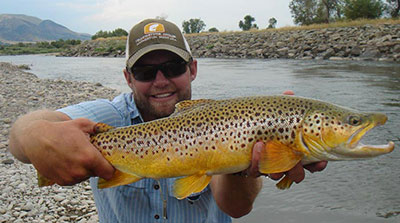
The Jeff is either on or off. Unfortunately for visiting anglers, a lot of the time it’s off. Like the Yellowstone, the Jeff holds some very large brown trout, and like the Stone those browns are smart and finicky about when they want to eat. The Jefferson fishes best early and late in the year. During July and August it is usually too low and too hot to spend time on.
If you are out here in the Spring or Fall and are interested in fishing the Jefferson, give us a call. We will know when you arrive if it is worth your efforts and money for that specific time period. It may take several trips here to come up with a trophy brown and it is not uncommon for clients and even expert local anglers to get skunked here. A potentially rewarding challenge!
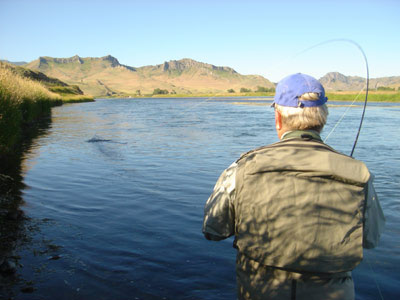
The Missouri river, or “MO” as many locals call it, is arguably the best river in Montana (if not the world) as far as hatches go. The MO is not only in a big fish cycle, but there are also good numbers of fish to boot – and they typically “pod” up in big, rising schools when various hatches are coming off. The most famous and popular hatches include Midges, Baetis, PMDs, and Tricos.
There are also several lesser-known hatches that can produce some incredible dry fly fishing if you know when to go and what to use. When conditions are right, the hopper and streamer fishing on the MO are second to none. It’s not uncommon for a boat to hit double digits on a good day, even with average-skilled anglers.
Part of the key to unlocking the MO’s potential is knowing when to go. It can get quite “weedy” and sometimes the only way to get action on the line is with nymphs on long leaders. June is typically a great month to go. The rest of the time, we’ll let you know if we think it’s worth the drive or not.
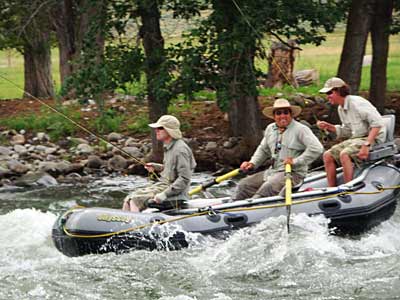
In addition to the major “blue ribbon” rivers of Montana, we also book several smaller rivers. Many of these streams are floatable in a raft (at least while water levels remain high enough to float). Others are too small to float and are better suited for wade fishing.
Although these rivers are smaller than their blue ribbon brothers, the fish they hold are often equal in size, and occasionally we’ll even see a fish in the 20” plus range. We don’t like mentioning the names of these rivers as they cannot handle the same pressure as the larger Montana rivers. If you are booking several days in a row, these smaller rivers offer a great way to change things up!
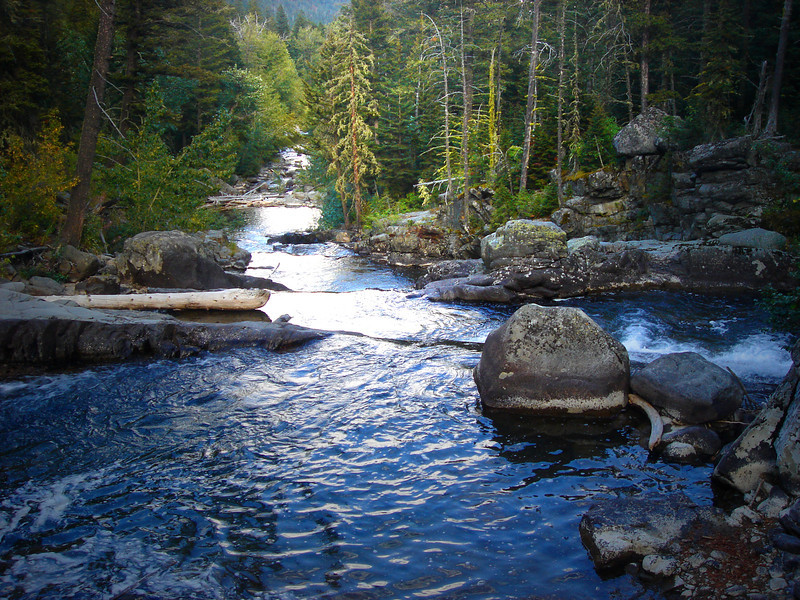
While Montana’s famous, big-name rivers are the main attraction for visiting anglers, our area also boasts numerous “off the map” fly fishing options that are an angler’s dream come true. We often refer to these spots as “stash waters” since they are more or less secret spots which the guides have found from living out here over the years. Needless to say we cannot mention the names of these rivers and streams and in many cases the guides won’t even tell us where their spots are. Some of these waters require special permits, others do not. Some of these waters are floatable in rafts and others are wade only. Each spot is a totally unique opportunity for world-class fly fishing away from the crowds!
When you call to book a trip, let us know what kind of experience you are looking for and we’ll make it happen. While the Yellowstone is always a favorite on the itineraries we create, we’ve found anglers really enjoy the change of pace and solitude these smaller and less pressured streams offer. Whether you like to fish dry flies, streamers, cover lots of water by walking, or site-nymphing we’ll have some ideas for you. Expect a slightly longer drive to get to some of these spots and don’t be surprised if your guide asks you to sign a non-disclosure form or wear a blindfold!